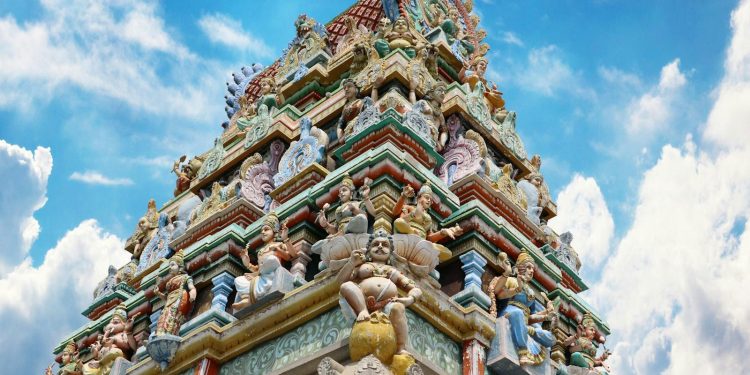India’s artistic heritage is a vibrant tapestry woven from centuries of diverse influences, deep traditions, and an endless quest for expression. From ancient cave paintings and intricate sculptures to elaborate dances and intricate textiles, the country’s cultural depth is revealed through the myriad art forms that have flourished over thousands of years. For those curious about the richness of India’s creative traditions, an exploration of its artistic heritage offers an eye-opening journey into its history, spirituality, and regional uniqueness. Each of these art forms tells a story, deeply connected to the cultural, spiritual, and historical context of its origin.
Ancient Cave Paintings: Windows to the Past
One of the oldest manifestations of India’s artistic heritage can be found in the country’s prehistoric cave paintings. The Bhimbetka rock shelters in Madhya Pradesh are a testament to the deep roots of India’s cultural history, with paintings that date back over 30,000 years. These vivid murals depict scenes from the daily life of prehistoric people—hunters, dancers, and communal gatherings. The use of natural pigments and the choice of imagery speak to the connection between early humans and their environment.
Further south, the murals of Ajanta and Ellora caves in Maharashtra offer a stunning glimpse into the cultural and religious life of ancient India. The Ajanta caves, created between the 2nd century BCE and the 6th century CE, are adorned with intricate frescoes depicting scenes from the life of the Buddha, mythological tales, and elements of everyday life. These paintings offer insight into the region’s devotion to Buddhism and showcase the skill of ancient Indian artists who captured the delicate interplay of light and shadow long before the development of Western artistic techniques.
Sculpture: The Embodiment of Divinity
Sculpture has always played a pivotal role in Indian artistic heritage, particularly as a means of expressing religious devotion. From the earliest Indus Valley terra-cotta figurines to the elaborate temple carvings of South India, sculpture in India has served as a bridge between the human and the divine. The intricate carvings found in the temples of Khajuraho, for instance, highlight the extraordinary craftsmanship of medieval India, where artisans captured the beauty of the human form in a wide array of poses, each charged with symbolism and meaning.
The temples of Tamil Nadu, such as Brihadeeswarar Temple in Thanjavur, showcase the Dravidian architectural style, with towering gopurams (gateway towers) covered in elaborate sculptures. These carvings depict stories from Hindu epics, celestial beings, and local deities, and serve as a form of visual storytelling that made spiritual narratives accessible to the masses. Beyond their religious purpose, these temples stand as enduring examples of India’s cultural synthesis—each region and dynasty adding its unique stylistic imprint to these sacred structures.
Classical Dance: Stories in Motion
India’s artistic heritage is not confined to static visual forms. Dance, a dynamic and expressive art form, holds a significant place in the cultural landscape of the country. Classical Indian dance forms such as Bharatanatyam, Kathak, Odissi, and Kathakali are more than just performances; they are elaborate visual narratives that combine music, facial expressions, hand gestures (mudras), and rhythmic movement to tell stories from mythology and history.
Bharatanatyam, one of the oldest classical dance forms, has its roots in Tamil Nadu and was traditionally performed in temples as an offering to the deities. This dance form, with its graceful yet powerful movements, intricate footwork, and expressive storytelling, embodies devotion and spirituality. Similarly, Kathak, which originated in the northern regions of India, blends elements of Hindu and Muslim cultures and was a popular form of entertainment in the royal courts of the Mughal era. The swift spins and expressive gestures of Kathak dancers tell tales of love, valor, and devotion, keeping alive the oral traditions passed down through generations.
The evolution of these classical dances reflects India’s rich history of cultural synthesis and adaptation, with influences from various religious, regional, and even colonial interactions shaping their development. Today, these dance forms continue to captivate audiences, offering glimpses into India’s mythological past and the stories that have shaped its culture.
Handloom Textiles: Weaving Stories of Tradition
Textiles have been an integral part of India’s artistic heritage for millennia, with each region of the country developing distinct weaving techniques, motifs, and styles. The art of weaving is a testament to the patience, skill, and creativity of Indian artisans, who pass down their knowledge from one generation to the next. Handloom textiles are not just fabric—they are cultural expressions that reflect the social, environmental, and historical context of their origin.
The Banarasi silk sarees of Varanasi, for instance, are known for their luxurious texture and intricate gold and silver brocade work. These sarees, often worn during weddings and special occasions, are a symbol of opulence and tradition. In contrast, the Kanchipuram silk sarees of Tamil Nadu are celebrated for their vibrant colors and bold patterns, often inspired by temple architecture and nature.
The handloom heritage of India extends beyond silk. The block-printed cotton fabrics of Rajasthan, the ikat weaves of Odisha, and the rich pashmina shawls of Kashmir each tell their own unique story. These textiles carry forward the cultural identity of their respective regions and are often created using traditional, eco-friendly techniques, making them sustainable and culturally significant works of art. The resurgence of interest in handloom textiles in recent years has helped to support rural artisans and preserve these traditional crafts in a rapidly changing world.
Miniature Paintings: Detailed Chronicles of History
The tradition of miniature painting in India is another testament to the country’s rich artistic heritage. Originating in the royal courts of the Mughals, Rajputs, and Pahari kings, these intricate paintings capture scenes from mythology, history, and the lives of the royals with astounding attention to detail. Mughal miniatures, in particular, are known for their delicate brushwork, vibrant colors, and the portrayal of courtly life, hunting scenes, and natural beauty.
Rajput miniature paintings, on the other hand, depict scenes from epics like the Ramayana and Mahabharata, as well as romantic tales of Krishna and Radha. The themes, style, and colors used in these miniatures vary from region to region, reflecting the diverse cultural influences and artistic traditions of each kingdom. The Pahari school, which developed in the Himalayan regions, is known for its lyrical depictions of love and devotion, often featuring lush landscapes that evoke the natural beauty of the region.
These miniature paintings, often created using natural pigments and fine brushes, are a celebration of detail and storytelling. They not only offer insights into the cultural and political life of their times but also stand as a testament to the technical prowess and imaginative capacity of Indian artists.
Folk Art: The Voice of the People
While India’s classical art forms often developed in temples and royal courts, its folk art has thrived in the homes and villages of the common people. Folk art forms like Madhubani, Warli, Pattachitra, and Gond painting are rich in symbolism and reflect the beliefs, rituals, and everyday lives of rural communities. Created using natural dyes and simple tools, these art forms are deeply connected to the cultural and spiritual practices of their regions.
Madhubani art, from the Mithila region of Bihar, is characterized by intricate patterns and vibrant colors, often depicting nature, mythology, and domestic scenes. Traditionally created by women on the walls and floors of their homes, Madhubani has now found a global audience, with its motifs adorning canvases, fabrics, and even urban murals. Similarly, Warli art, from the tribal communities of Maharashtra, uses simple geometric shapes to depict scenes of daily life, farming, festivals, and animals. The stark, monochromatic imagery of Warli art speaks to the connection between the community and their environment.
These folk art traditions are a reminder that art in India is not restricted to galleries and museums—it is woven into the fabric of daily life, a living expression of the culture and values of its people. The resurgence of interest in Indian folk art, both within the country and internationally, has helped to ensure that these traditions are preserved and passed on to future generations.
Music: The Soul of India’s Artistic Expression
No exploration of India’s artistic heritage would be complete without mentioning its rich musical traditions. Classical Indian music, with its roots in the Vedic period, has evolved into two distinct styles: Hindustani in the North and Carnatic in the South. Both styles are deeply spiritual and complex, relying on ragas (melodic frameworks) and talas (rhythmic cycles) to evoke specific emotions and moods.
In addition to classical music, India boasts a wide range of folk music traditions, each reflecting the cultural heritage of its region. From the soulful Baul singers of Bengal to the energetic Bhangra of Punjab, folk music in India is a reflection of the country’s diversity, telling stories of love, devotion, and social issues. The blending of classical, folk, and contemporary influences has given rise to new musical forms that continue to evolve, yet remain deeply rooted in India’s cultural traditions.
The Ever-Evolving Legacy
India’s artistic heritage is not a relic of the past but a living, evolving tradition that continues to inspire and adapt. The blending of old and new, traditional and contemporary, makes Indian art dynamic and ever-relevant. The country’s rich artistic legacy is not confined to any one medium or region—it is expressed through its temples, textiles, dances, paintings, and music, each contributing to the cultural depth and diversity of this vibrant nation.
Exploring the cultural richness of India’s artistic heritage is a journey through time, offering a deeper understanding of the country’s identity, its values, and its worldview. From the ancient caves of Bhimbetka to the bustling workshops of contemporary artisans, India’s art is a reflection of its resilience, spirituality, and boundless creativity. For anyone seeking to understand India, its art provides an authentic window into the heart of its culture.
















